What is Omnichannel Customer Service

Preetam Das
July 04, 2025
19 min
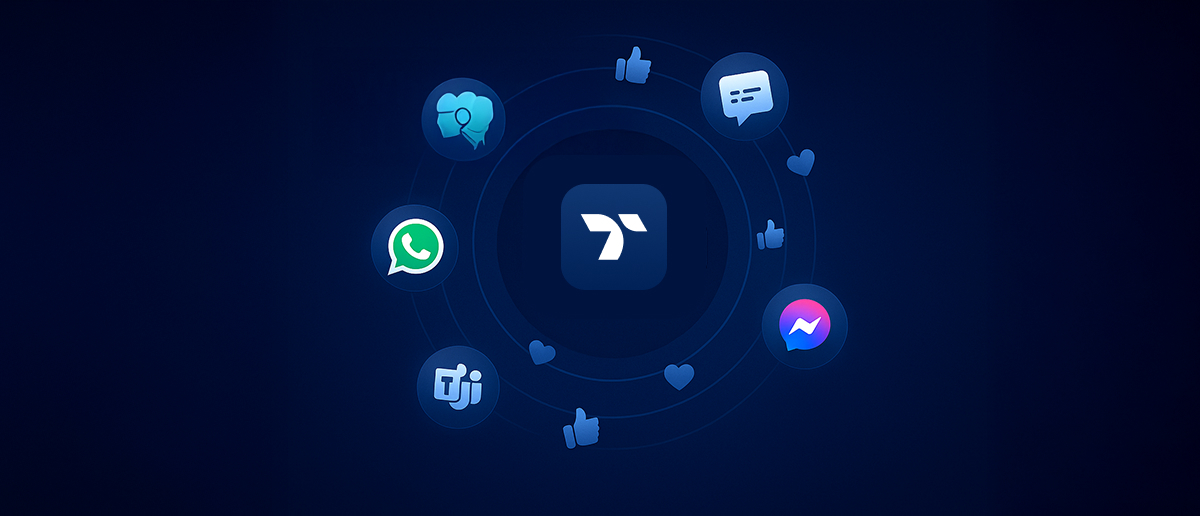
Table of Contents
Today, customers are spoiled for choice, and this makes the competition tough for businesses in the market. For businesses, it is crucial to understand that to gain an edge in the competitive market, personalization is the key.
A personalized omnichannel customer service allows businesses to tailor support based on individual customer needs, preferences, and past interactions, making customers feel more valued, seen, heard, and understood .
The reason for this is that today’s consumer has the opportunity to design their own journey across an organization’s touchpoints. Modern consumers expect fast, seamless, and effortless support regardless of the channel they choose.
83% of individuals state that personalization directly increases their brand loyalty.
What is Omnichannel Customer Service

Customers today want quick, real-time responses. They expect to interact with a brand instantly, whether that’s online, on mobile, or even in a physical store. And with each interaction, they want the experience to feel connected. The context of their issue should carry over, so they don’t feel like they’re starting from scratch every time.
That’s exactly what omnichannel customer service is about. It’s a customer-centric, cohesive approach to support that makes the experience feel consistent and connected across every channel. Whether a customer reaches out through email, website chat, phone, social media, or a messaging app, the system keeps track of their history and context. Each new interaction builds on the last, which makes the entire process smoother and more personal.
Something that happens to me all the time is I’ll start with a chatbot when I have an issue. But very quickly, the problem gets more complicated, and I have to switch to a phone call or send an email.
Instead of explaining everything all over again, I just want to pick up where I left off. That’s the difference omnichannel makes. It’s not about having lots of channels, it’s about making them work together in a seamless way.
Omnichannel customer service is a unified support strategy that connects all customer communication channels, including email, phone, live chat, social media, messaging apps, and self-service tools into one integrated system. It ensures the customer experience stays smooth, efficient, and personalized, no matter how many times the customer switches between channels.
Key Characteristics of Omnichannel Customer Service
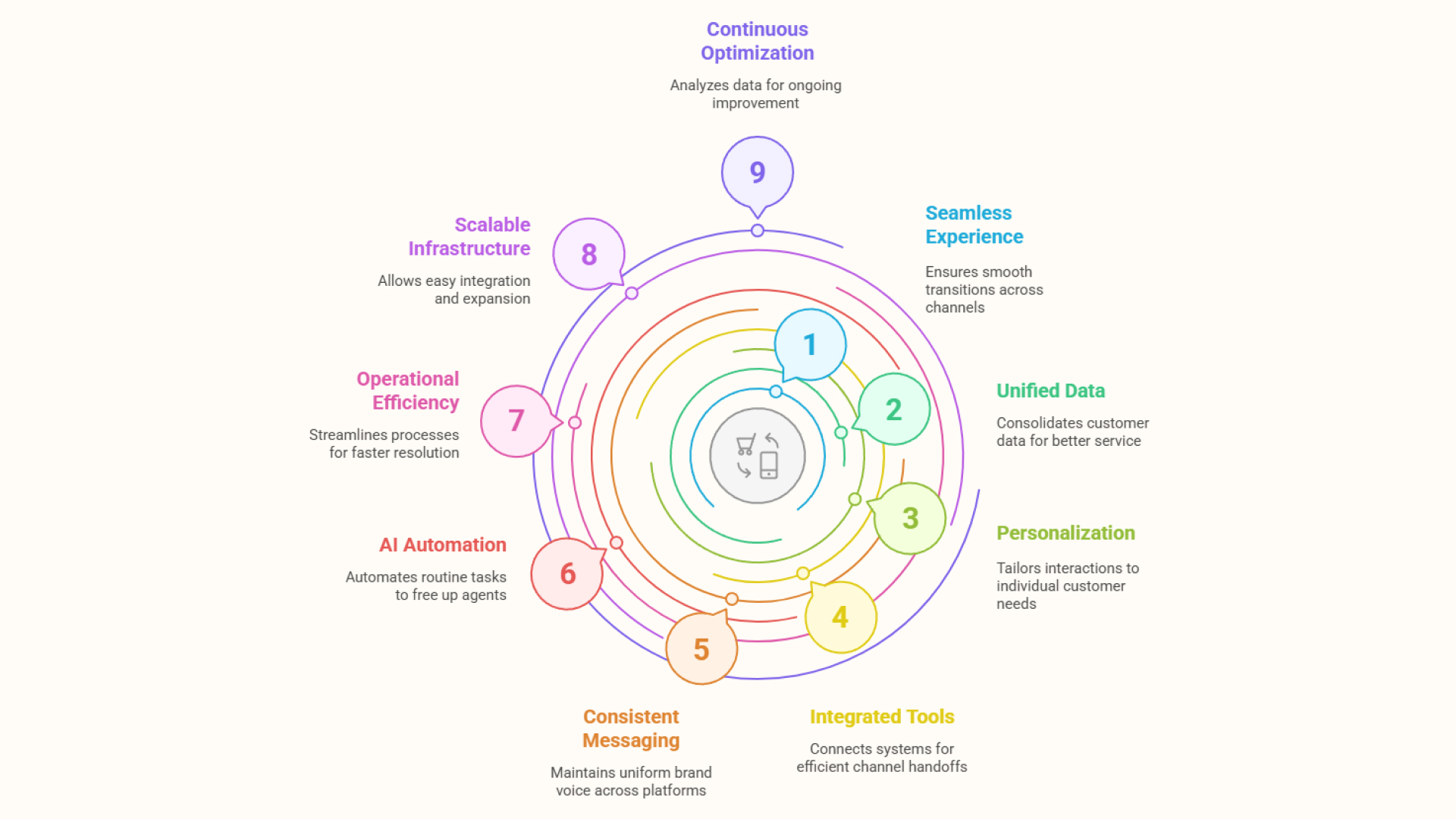
A strong omnichannel strategy isn’t just about technology, it’s built on a set of core principles that shape how support is delivered.
Seamless and consistent experience
Customers can interact across different channels, live chat, email, phone, or in-store, without any disruption. The context from previous interactions is carried forward, making the experience feel like one continuous conversation. This reduces friction, saves customer effort, and increases satisfaction.
Yet, only 25% of consumers say they receive a consistent experience across channels, despite 75% expecting it.
Unified customer data and context preservation
All customer interactions and data are consolidated into a single system, usually through a customer data platform (CDP). Support agents have access to complete customer history in real time, allowing them to respond with relevant information and avoid repeated questions. This improves resolution speed and personalization.
Personalization at scale
With integrated data and AI, businesses can deliver support that adapts to each customer’s behavior, preferences, and lifecycle stage. This includes personalized responses, product recommendations, and proactive outreach. It helps form deeper customer connections and keeps people coming back.
Integrated communication tools and channel handoffs
Systems are connected so that customers can switch between channels from chat to phone, or bot to human, without losing progress. Internal tools sync instantly, ensuring support agents are fully updated. This improves efficiency and delivers a more professional customer experience.
Integrated omnichannel tools lead to a 31% reduction in first-resolution times and a 39% drop in wait times.
Consistent messaging and brand voice
Customers receive uniform messaging and tone across all platforms, including email, social media, live chat, and more. Consistent messaging across channels reduces confusion, strengthens your brand, and helps customers feel more confident in your service.
Research shows that 67% of consumers prefer brands offering consistent omnichannel experiences.
AI-powered automation
Routine tasks like FAQs, order tracking, and appointment booking are handled by AI chatbots and automation tools. Support teams can focus on more complex, high-value problems instead of routine tasks. Automation and smart routing lower customer wait times and ensure support is available when and where it’s needed.
Operational efficiency
With centralized data, automated routing, and integrated tools, teams resolve issues faster and with fewer resources. This lowers support costs, increases agent productivity, and improves first-contact resolution rates.
Scalable and flexible infrastructure
Omnichannel systems are built on modern, API-driven architectures that allow easy integration and expansion. New tools and channels can be added smoothly, without interrupting current systems or processes. This supports long-term growth and adaptability.
Continuous optimization through analytics
Data from all customer interactions is analyzed to uncover patterns, bottlenecks, and opportunities. This enables continuous improvement of service strategies, better decision-making, and higher customer satisfaction over time.
Finding the right tool that fits your business requirements while addressing the core essentials of omnichannel customer service can be challenging. Many solutions promise multichannel capabilities but fall short when it comes to true integration, personalization, and long-term scalability.
Thinkstack makes it easy to connect with customers where it counts like WhatsApp, while ensuring smooth human handoffs when needed. With smart conversational AI forms and Facebook Messenger integration, your support stays personal and responsive.
Try Thinkstack’s AI in action
Schedule a demo now.Omnichannel vs. Multichannel Customer Service
While both omnichannel and multichannel approaches involve interacting with customers across multiple platforms, the key difference lies in how those platforms work together. Integration, continuity, and shared customer context are what set omnichannel apart.
Being multichannel doesn’t mean a business is providing omnichannel customer service. If each channel operates in isolation without shared data or conversation history, the customer experience remains fragmented. Omnichannel customer service, on the other hand, ensures that all interactions are connected, context-aware, and part of a single, seamless support journey, not just multiple disconnected touchpoints.
| Aspect | Multichannel customer service | Omnichannel customer service |
|---|---|---|
| Integration | Channels operate in silos with minimal or no connection. | Channels are fully integrated, sharing data and context in real time. |
| Customer context | Lost between channels, customers often repeat themselves. | Preserved across all channels, the experience continues seamlessly. |
| Customer journey | Fragmented and inconsistent across platforms. | Unified and continuous across all touchpoints. |
| Focus | Channel or product-centric. | Customer-centric. |
| Data flow | Data stays isolated within each platform. | Centralized data for a 360° customer view. |
| Team collaboration | Departments and systems often work independently. | Cross-functional teams work from shared data and tools. |
| Personalization | Limited, as insights are fragmented. | Deep and dynamic, powered by unified data and AI. |
| Customer experience | Inconsistent, with high effort for the customer. | Consistent, low-effort, and contextually relevant. |
| Technology dependency | Relies on separate systems or point solutions. | Depends on an integrated tech stack (CDP, APIs, AI tools). |
| Scalability | Harder to scale efficiently without data unification. | Designed to scale with centralized systems and automation. |
Key Components of an Effective Omnichannel Strategy
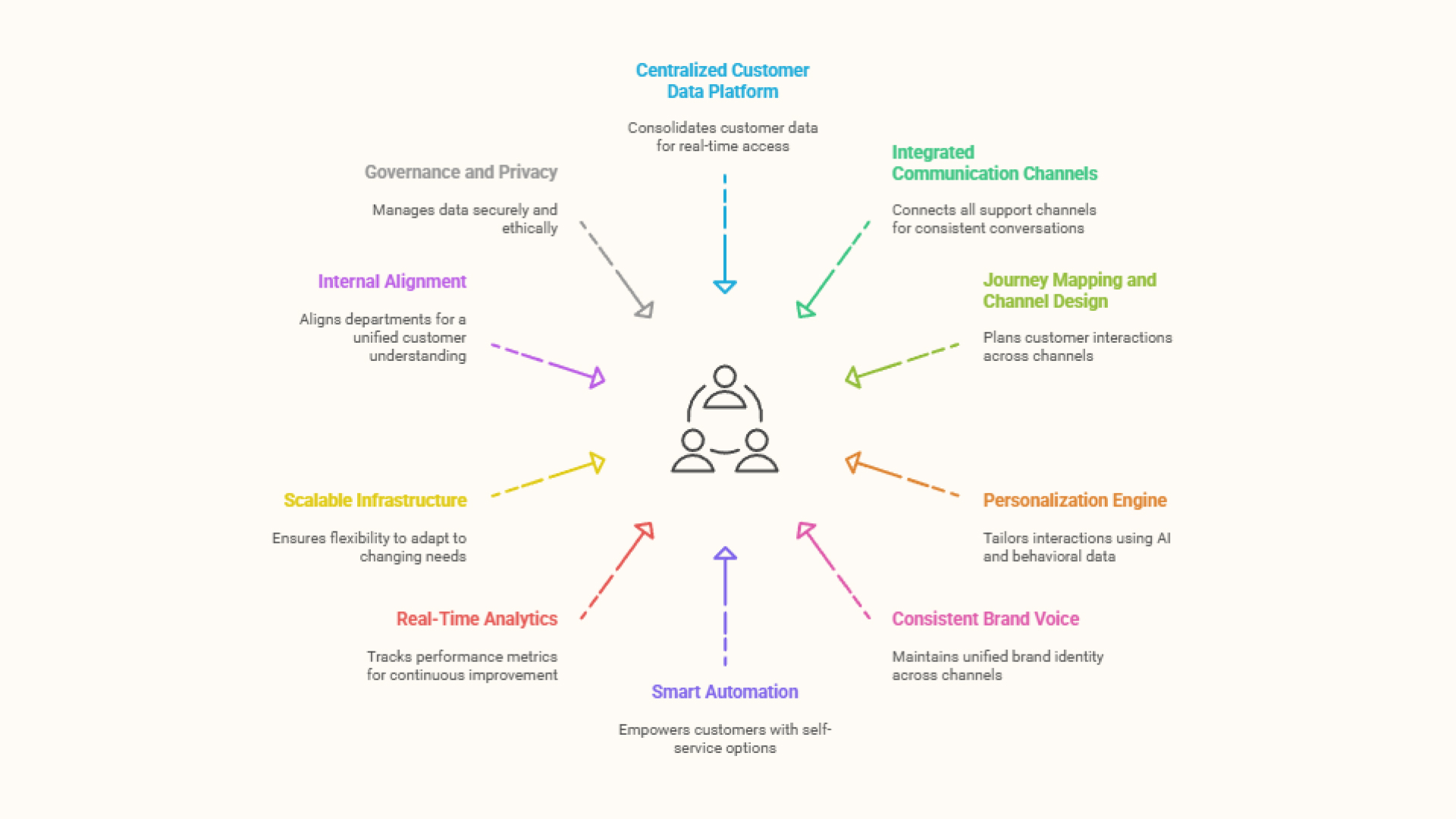
Implementing a successful omnichannel customer service strategy isn’t just about being present on multiple platforms. It’s about making those platforms work together, not in silos. Businesses need a long-term plan that aligns people, processes, and technology around the customer journey. A clear strategy removes silos, reduces friction, and ensures support is consistent, scalable, and based on actual customer behavior.
- Centralized customer data platform (CDP)
A CDP consolidates customer data from every touchpoint, including support tickets, chat logs, web behavior, email interactions, and purchases, into one unified system. Support teams get instant access to full customer info, helping them reply faster and with better context. The result is fewer repeated questions, quicker resolutions, and a more personalized customer experience. Example: NA-KD
The fashion retailer implemented a centralized CDP using Insider’s platform to unify fragmented customer data. With this unified profile, they launched hyper-personalized campaigns, resulting in a 25% increase in Customer Lifetime Value (CLTV) and a 72x ROI within 12 months. - Integrated communication channels
All support channels, including phone, live chat, email, social media, mobile apps, and in-store systems, must be technically connected and synchronized. This integration allows conversations to move between channels without losing context, ensuring consistency and reducing customer frustration. It also equips agents with full visibility into customer interactions, regardless of the entry point. - Journey mapping and channel design
Journey mapping involves understanding and planning how customers interact across various channels throughout their lifecycle. This helps identify friction points and design intentional, low-effort pathways for customers to find help, make purchases, or resolve issues. Proper mapping ensures proactive support and a more fluid overall experience. - Personalization engine (AI + behavioral insights)
Personalization at scale relies on combining AI with real-time behavioral data to tailor interactions, recommendations, and support. Whether it’s sending contextual messages or surfacing relevant help content, this engine helps businesses meet rising customer expectations for relevance. It drives higher engagement, conversion, and long-term loyalty. - Consistent brand voice and messaging
Maintaining a unified brand identity across all channels is critical. This includes tone, language, visuals, and even the cadence of communication. Consistency builds brand trust, reinforces credibility, and ensures that customers always know what to expect from your company, whether they’re chatting with support or reading an email. - Smart automation and self-service options
Automation tools such as chatbots, conversational workflows, and searchable help centers empower customers to resolve simple queries on their own. This improves service availability, reduces wait times, and allows agents to focus on complex issues. When done right, self-service enhances efficiency without compromising on experience. - Real-Time analytics and optimization
Capturing real-time data across channels is essential for measuring what’s working and what’s not. Analytics dashboards track interaction volume, satisfaction scores, resolution times, and agent performance. These insights drive continuous improvement by highlighting areas to refine and helping teams stay aligned with customer needs. - Scalable, flexible infrastructure
A modern omnichannel system must be agile. This means having a cloud-based, API-first architecture that allows businesses to integrate new tools, launch additional channels, or modify workflows without overhauling their entire setup. Flexibility ensures that support systems can evolve with the business and customer behavior. - Internal alignment and training
Cross-functional alignment ensures that departments like sales, marketing, product, and support share a common understanding of the customer. Teams must have access to shared data, consistent training, and unified performance metrics. This collaboration eliminates silos and enhances the customer experience through coordinated, informed interactions. - Strong governance, privacy, and consent
With growing concerns around data privacy, businesses need clear policies and secure systems to manage how customer data is collected, stored, and used. Consent management tools and compliance frameworks (e.g., GDPR, CCPA) are critical to building customer trust. Proper governance protects both the customer and the business over time.
Benefits of Omnichannel Strategy
An effective omnichannel strategy doesn’t just change how service is delivered, it changes how value is created for both customers and businesses. The ability to provide connected, context-rich interactions across platforms translates directly into stronger relationships, higher satisfaction, and measurable business outcomes. This level of consistency and personalization is what defines customer service excellence today.
Customer-Centric Benefits
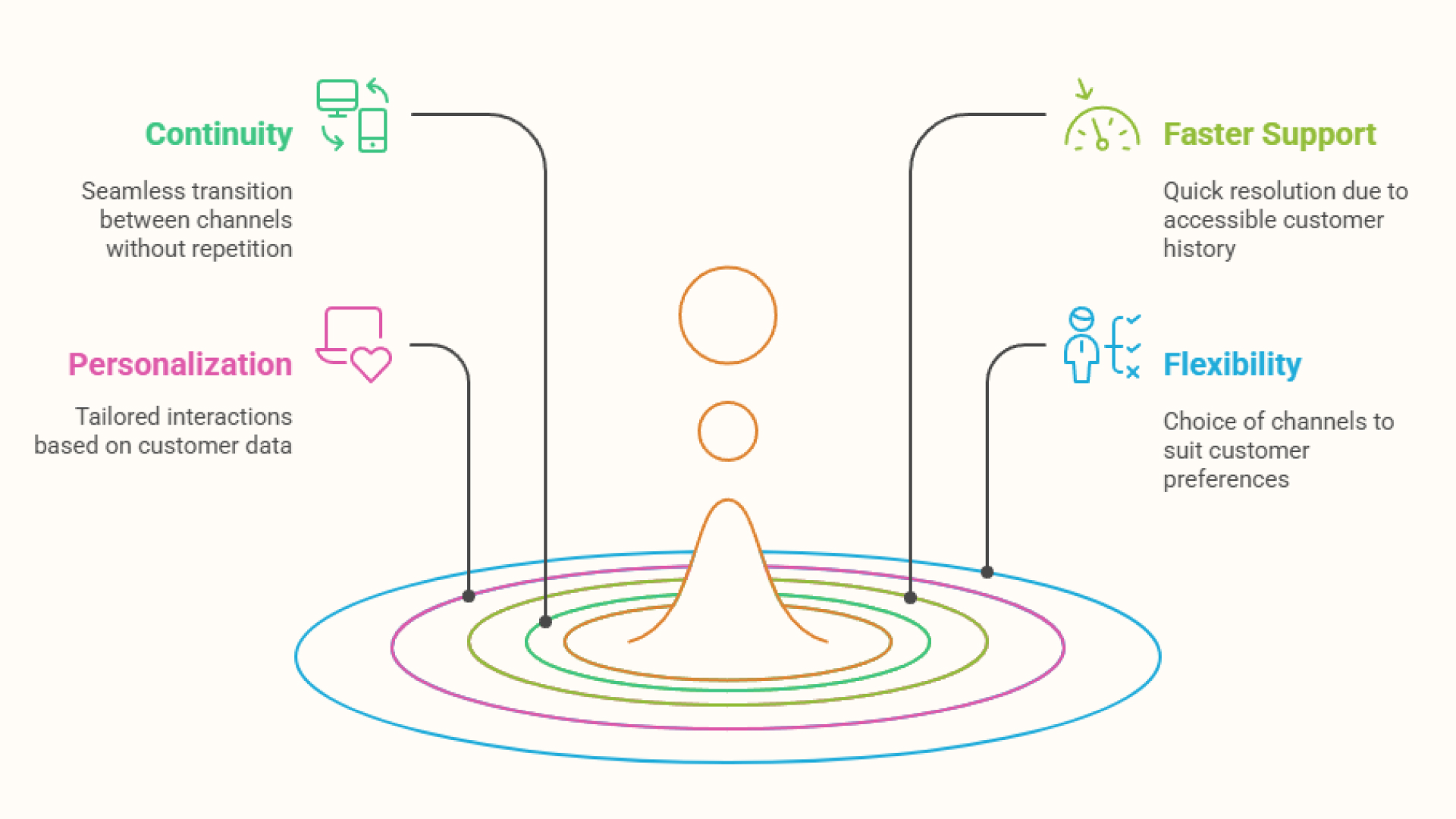
- Continuity across channels
Customers can switch between channels without losing progress or repeating themselves. A smooth handoff between channels cuts down effort, resolves issues quicker, and makes customers happier. Businesses with strong omnichannel continuity see 67% CSAT, 31% faster resolution, and up to 89% retention. - Faster and easier support
Omnichannel systems sync customer history and interactions across all touchpoints, giving agents complete context. Reps don’t start from scratch, they pick up where the last conversation left off, making support faster, smoother, and more personalized. This reduces effort for the customer and increases satisfaction, loyalty, and repeat usage. - More personal and relevant interactions
Omnichannel systems make it easier to deliver personalized support. By drawing on unified data, companies can tailor messages and recommendations to individual preferences or behavior. Personalization leads to stronger trust, with 76% of consumers more likely to buy from brands that personalize their experience. - Flexibility and convenience
Customers have the freedom to use their preferred channels, messaging apps, social DMs, email, or voice, without compromising service quality. This flexibility matches modern communication habits and makes support more accessible and effortless.
Business-Facing Benefits
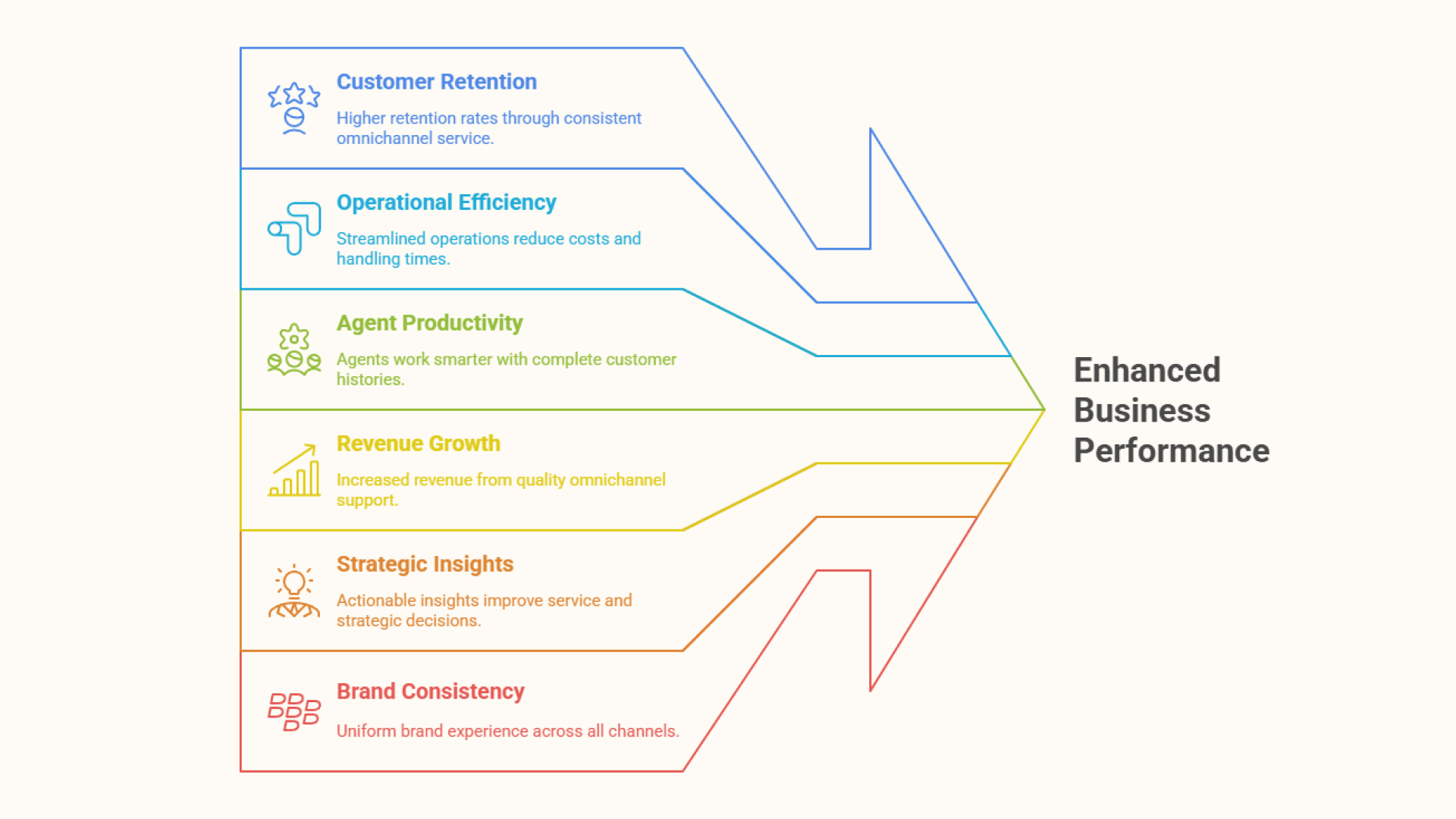
- Higher customer retention and loyalty
Businesses can reduce customer acquisition costs and grow revenue by retaining loyal, repeat customers. When support feels the same on every channel, it earns trust and encourages repeat business. Companies with strong omnichannel strategies retain up to 89% of their customers, compared to just 33% for those with fragmented systems. - Greater efficiency and reduced costs
Omnichannel systems reduce manual effort by centralizing data and automating routine tasks. Agents resolve issues faster with fewer handoffs, cutting down on queues, handling time, and support costs. - Better agent performance
With full access to customer history and automated routing, agents work more efficiently. They spend less time on repetitive work and more time on high-value issues, leading to better outcomes, lower burnout, and higher team productivity. - Improved revenue and conversion rates
Fewer barriers across the customer journey mean more conversions. Customers who experience smooth, connected support are 3.6× more likely to buy again, raising order value and overall lifetime value. - Actionable insights and smarter decisions
A unified platform captures data from every touchpoint. This gives teams end-to-end visibility into behavior, pain points, and performance, enabling smarter decisions that improve service design and customer outcomes. - Brand consistency across every touchpoint
Messaging and tone stay aligned across all channels from social DMs to in-store visits. This consistency builds brand trust, reinforces professionalism, and ensures every interaction feels familiar and reliable. - Scalability and future readiness
Omnichannel systems are built to grow. As new channels emerge or customer habits shift, businesses can expand without overhauling their tech, keeping service agile, modern, and always aligned with expectations.
Check out: How B2B customer service is evolving with proactive tools, automation, and CX strategies.
Challenges of Omnichannel Strategy
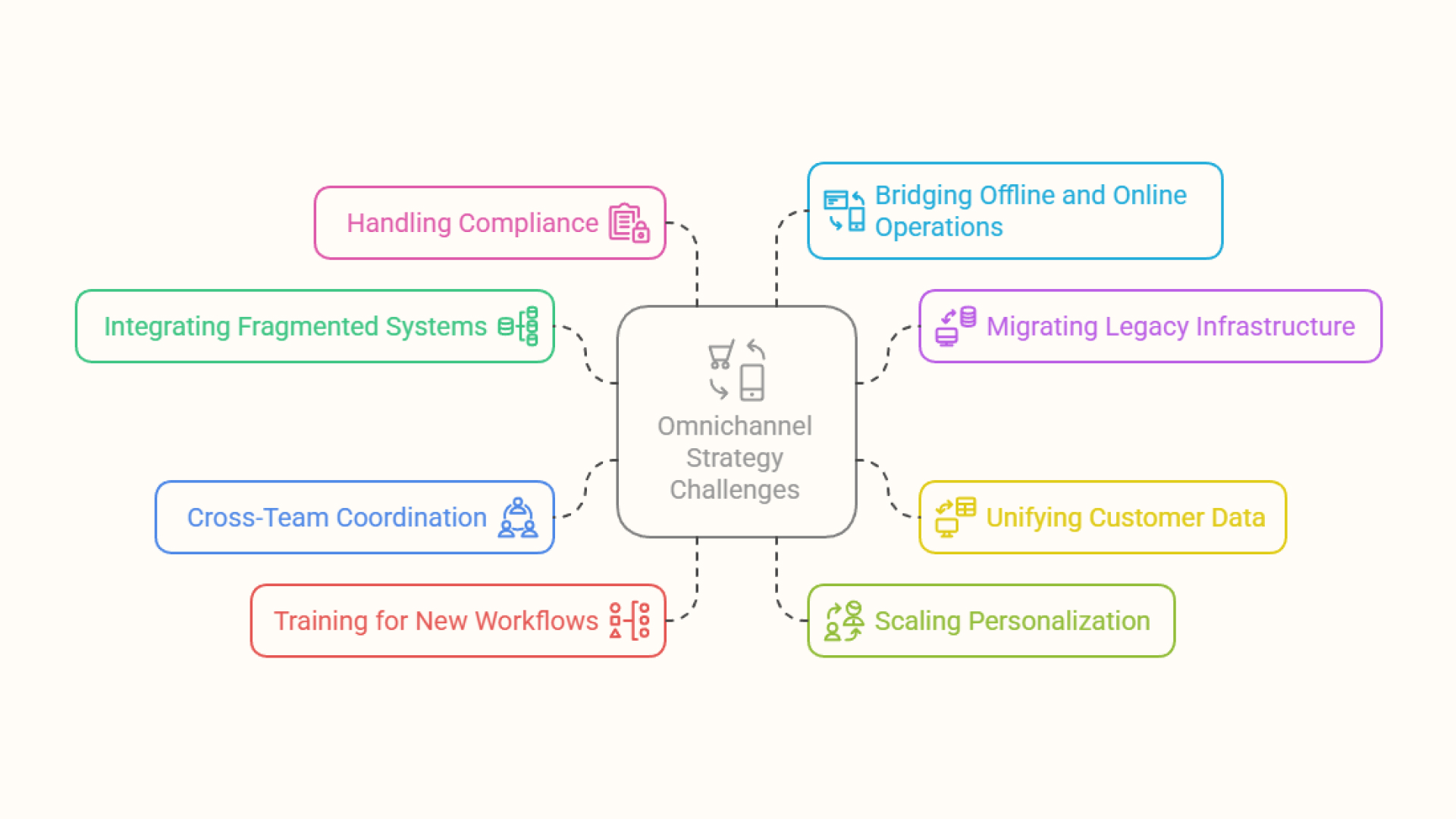
- Integrating fragmented systems
One of the first hurdles in implementing omnichannel service is stitching together tools that weren’t built to work together. Customer data, communication logs, and workflows often sit in separate systems, making integration technically complex and resource-heavy. Without a unified backend, consistency across channels becomes impossible to deliver. - Migrating legacy infrastructure
Many businesses still rely on outdated platforms that can't support real-time syncing or flexible integrations. Transitioning to scalable, API-first systems often means overhauling existing architecture, which demands significant time, investment, and IT capacity. - Unifying customer data
Consolidating customer information from different sources into a single, usable profile requires deep data cleanup and governance. Without clean, centralized data, personalization efforts fall short, and agents can’t access the context needed for seamless interactions. - Cross-team coordination
Omnichannel service depends on collaboration across departments like support, marketing, sales, product but these teams often operate in silos with different goals. Aligning them requires shared workflows, consistent messaging, and clear ownership of the customer journey. - Training for new workflows
Shifting to omnichannel means agents need to learn new tools, manage more dynamic conversations, and switch between channels without losing momentum. Without proper training, this transition slows productivity and leads to inconsistent service. - Scaling personalization
As businesses grow, maintaining personalized interactions across channels becomes harder. Delivering tailored service at scale requires automation, predictive tools, and a smart balance between human and machine-driven support. - Handling compliance in a unified setup
Bringing all interactions into a single system raises the stakes for data privacy. With more customer data in one place, businesses must ensure compliance with evolving regulations and build secure, consent-based frameworks from the ground up. - Bridging offline and online operations
For brands with physical stores, dealers, or franchise partners, syncing digital systems with in-store operations is especially complex. Legacy processes, inconsistent inventory tracking, and unaligned service protocols make it difficult to deliver a unified customer experience.
How to Build and Launch an Effective Omnichannel Customer Service Strategy
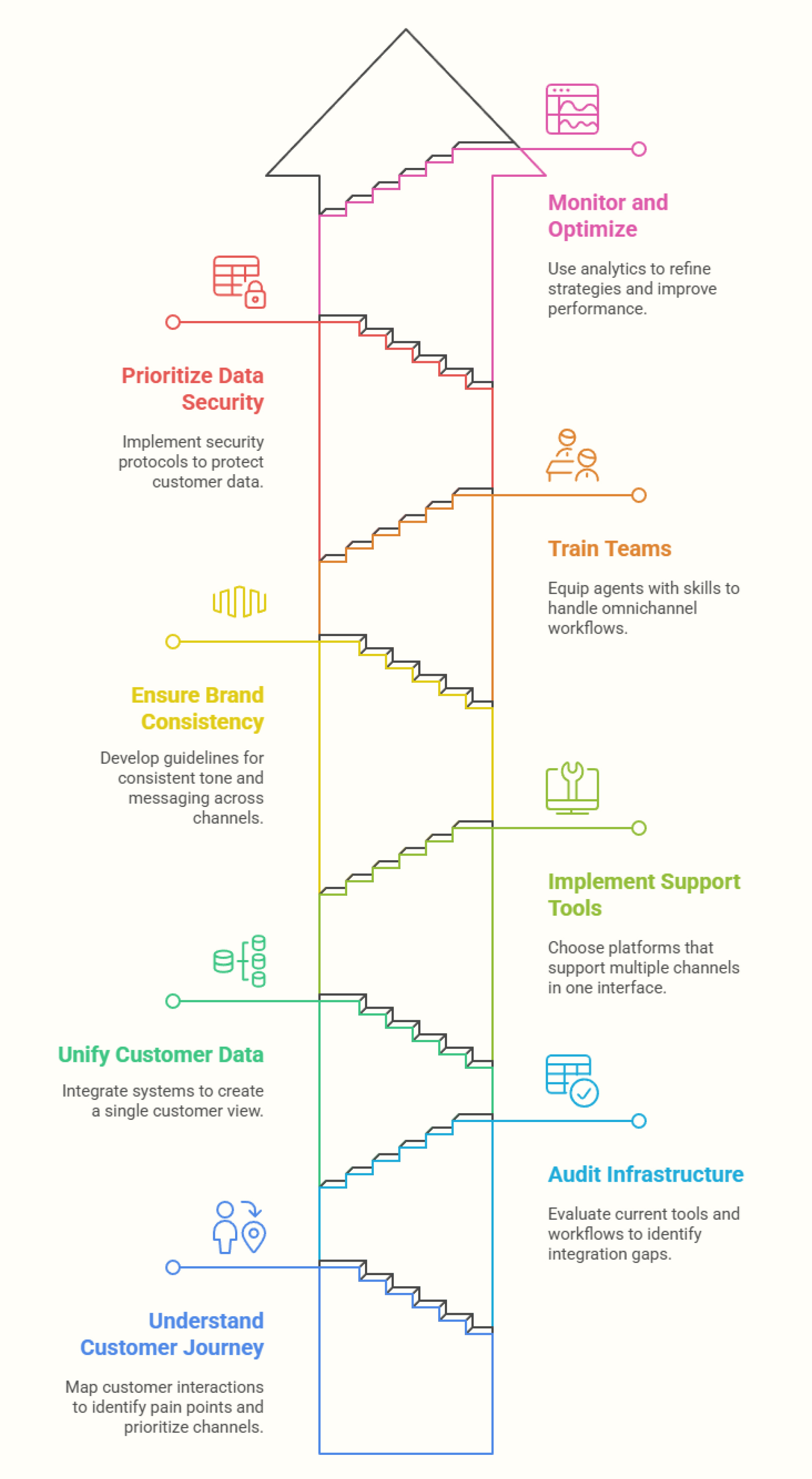
Implementing omnichannel customer service requires more than adding channels or launching a new CRM. It involves creating a unified support ecosystem. Omnichannel implementation is not a one-time project; it’s a shift in how support is delivered. With the right systems, training, and strategy, businesses can meet rising customer expectations.
Understand the customer journey and channel use
Start by identifying how customers interact with your business today. Map common customer journeys, from discovery to support, and pinpoint where customers switch between channels. Understanding these paths reveals pain points and informs which channels to prioritize.
Audit current infrastructure and capabilities
Evaluate your current tools, workflows, and data flows. Identify where data silos exist, how teams manage interactions, and where inconsistencies or handoff delays occur. This assessment reveals integration gaps and sets the foundation for planning improvements.
Unify customer data across systems
Integrate systems like CRM, helpdesk, ecommerce platforms, and POS to build unified profiles. This enables context-aware support, eliminates repetitive questions, and improves resolution speed.
Implement channel-agnostic support tools
Choose customer service platforms that support multiple channels within one interface. This allows agents to manage conversations from chat, email, phone, and social media in one place, with context preserved. Ensure these tools also allow for automation, AI support, and routing logic.
Ensure brand consistency across touchpoints
Develop clear brand guidelines for tone, visuals, and messaging. Use centralized content systems to maintain consistency in responses, promotions, and knowledge base content across all channels.
Train teams for omnichannel workflows
Equip agents with training that prepares them to switch between channels smoothly and use customer context effectively. Emphasize collaborative workflows, escalation processes, and how to maintain a consistent tone across formats.
Prioritize data security and privacy
As customer data becomes more centralized, ensure that compliance, security protocols, and consent management are built into all systems. Adopt tools with role-based access and audit trails to stay ahead of privacy regulations.
Launch in phases and iterate
Roll out omnichannel in stages, start with your most-used channels, and expand. Collect feedback from agents and customers, monitor KPIs like CSAT, resolution time, and channel-specific performance, and adjust your strategy based on results.
Monitor performance and optimize
Use analytics dashboards to track end-to-end customer journeys, identify drop-offs, and compare channel effectiveness. Continuously refine content, workflows, and agent training based on data insights.
Conclusion
Omnichannel customer service is no longer optional, it’s essential for brands that want to stay relevant and competitive. As customer expectations evolve, businesses must shift from fragmented support toward unified, intelligent systems that make service feel seamless and personal at every step.
At the heart of this shift is customer data. By linking up customer info across different systems, businesses can give people hyper-personalized experiences that actually feel relevant and timely. Predictive analytics, behavioral triggers, and AI-powered personalization enable companies to anticipate needs, tailor interactions, and move from reactive support to proactive engagement, all while respecting privacy and compliance.
To be ready for the future, businesses need to get the 4 C’s of omnichannel right.
- Context: Know who the customer is and what they’ve done before. Every interaction should pick up where the last one left off.
- Channel: Deliver a connected experience across all platforms, chat, email, voice, social, so customers can choose what works best for them.
- Content: Surface relevant, timely, and personalized information dynamically, based on behavior and preferences.
- Continuity: Ensure no interruptions as customers move between channels, conversations, and context flow without friction.
Emerging technologies like generative AI, voice commerce, augmented reality, and IoT are pushing omnichannel service beyond support, toward fully orchestrated customer journeys.
Omnichannel isn’t about being everywhere, it’s about being connected everywhere. The brands that get this right will see measurable gains in satisfaction, retention, efficiency, and lifetime value.
To make that work, choosing the right platform matters.
Thinkstack is a no code AI chatbot builder platform that brings everything into one place, unified inboxes, cross-channel conversations, and centralized customer profiles so your team can deliver faster, smarter service without switching tools. Use advanced LLM models like ChatGPT to build AI-powered chatbots for customer support, sales agents, internal AI agents, and automate workflows in just a few clicks, all without writing a single line of code.
Still unsure? See Thinkstack’s AI in action
Get started for freeFrequently Asked Questions (FAQs)
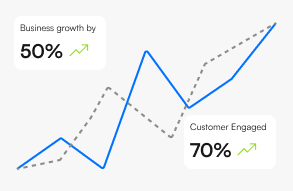
Grow Your Business with AI Agents
- Automate tasks
- Engage customers 24/7
- Boost conversions